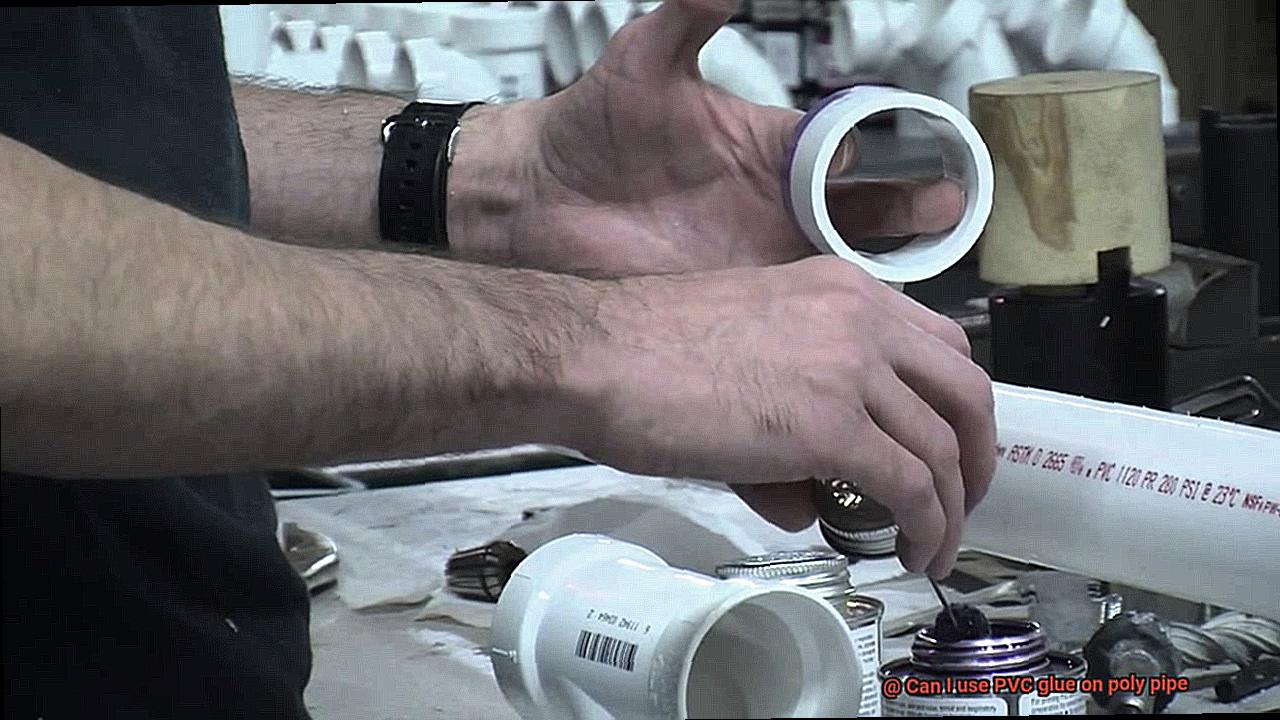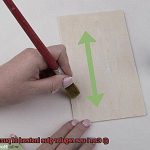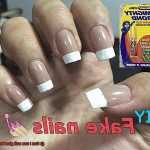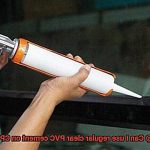Ever wondered if PVC glue and poly pipe are a match made in heaven? Well, wonder no more because today we’re diving deep into the captivating world of pipe adhesives. As experts in the field, we’re here to uncover the truth behind this age-old question that has left homeowners scratching their heads. Can you really use PVC glue on poly pipe? Stick around as we unravel the secrets, debunk myths, and equip you with all the knowledge you need to ensure your plumbing projects hit the bullseye. It’s time to untangle this adhesive affair, so let’s jump right in.
What is PVC Glue?
Contents
- 1 What is PVC Glue?
- 2 What is Poly Pipe?
- 3 Are PVC Glue and Poly Pipe Compatible?
- 4 Why You Should Not Use PVC Glue on Poly Pipe
- 5 What Adhesive to Use Instead of PVC Glue on Poly Pipe
- 6 How to Prepare the Surface of Poly Pipe for Adhesive Bonding
- 7 Instructions for Applying Specialized Adhesives to Poly Pipe
- 8 Conclusion
When it comes to plumbing, irrigation, or electrical conduit installations, having secure and leak-proof connections is of utmost importance. That’s where PVC glue comes into play. In this comprehensive guide, we will delve into the world of PVC glue, exploring its properties, applications, compatibility, advantages, and best practices for optimal results.
What is PVC Glue?
PVC glue, also known as PVC adhesive or PVC cement, is a specialized solvent-based adhesive formulated to join pieces of PVC (polyvinyl chloride) pipe and fittings together. This powerful adhesive chemically softens the PVC material, allowing it to fuse together under pressure and create a strong and reliable bond.
Applications:
PVC glue finds extensive use in various applications where PVC pipes are used. It is commonly employed in plumbing systems to ensure leak-proof connections that withstand the test of time. It is also crucial for irrigation systems, guaranteeing efficient water flow without any leaks or breaks. Additionally, PVC glue is essential for electrical conduit installations, providing secure connections for the safe transmission of electricity.
Compatibility:
To achieve optimal results, it is important to note that PVC glue should only be used with PVC materials. Attempting to use it on other types of plastic pipes like polyethylene or polypropylene can result in weak bonds or no bond at all. This can lead to leaks or pipe failure, compromising the integrity of the system.
Advantages:
In addition to its bonding properties, PVC glue offers several advantages. Firstly, it exhibits excellent resistance to chemicals commonly found in plumbing systems, such as water, sewage, and cleaning agents. This ensures that the connections remain strong and intact even when exposed to harsh substances. Secondly, PVC glue possesses good temperature resistance, making it suitable for both hot and cold water applications.
Best Practices:
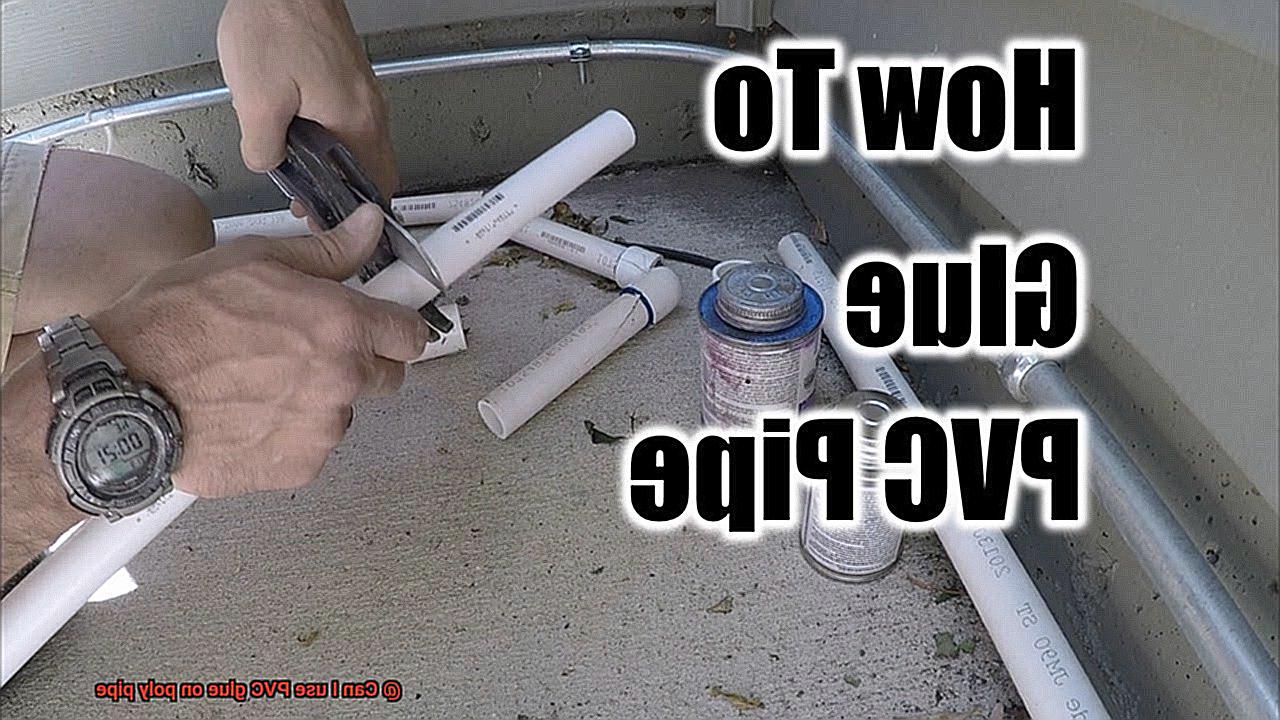
To ensure successful connections with PVC glue, it is important to follow these best practices:
- Clean and dry the surfaces being glued, ensuring they are free from any debris or contaminants that could hinder the bonding process.
- Apply the adhesive evenly and sparingly, avoiding excessive amounts that could lead to oozing out of glue.
- Press the surfaces together firmly for a short period of time to allow the adhesive to bond properly.
- Allow sufficient curing time before subjecting the joint to stress or pressure, as this ensures a strong and durable connection.
What is Poly Pipe?
When it comes to plumbing and irrigation systems, you need a pipe that can handle the pressure. That’s where poly pipe comes in. Poly pipe, short for polyethylene pipe, is a flexible plastic pipe that is the superhero of the plumbing world.
Made from either high-density polyethylene (HDPE) or low-density polyethylene (LDPE), poly pipe is known for its durability and resistance to corrosion. It’s the reliable choice for all your plumbing needs.
But what sets poly pipe apart from other types of pipes? Well, for one, it’s incredibly versatile. Need to navigate around obstacles or follow a curvy path? No problem. Poly pipe can be easily bent and manipulated to fit any installation requirement.
Another advantage of poly pipe is its ability to withstand harsh weather conditions. From freezing temperatures to scorching heat, poly pipe can handle it all. It’s also resistant to UV radiation and chemicals, ensuring its longevity and reliability.
Size matters when it comes to poly pipe. You can find it in various sizes, ranging from half an inch to several inches in diameter. The size you choose depends on the intended use and the flow rate required for your system.
Now, let’s talk connections. Poly pipe typically uses compression fittings or barbed fittings to create secure and watertight joints. These fittings are designed specifically for poly pipe, ensuring compatibility and preventing leaks.
In conclusion, poly pipe is a reliable and cost-effective solution for all your plumbing and irrigation needs. Its flexibility, durability, and resistance to environmental factors make it a popular choice among homeowners, farmers, and professionals alike.
Are PVC Glue and Poly Pipe Compatible?
When it comes to plumbing and irrigation systems, selecting the appropriate materials is paramount for a dependable connection. A common query that often arises is whether PVC glue and poly pipe are compatible. As an expert in the field, I’m here to illuminate this topic.
PVC glue, also known as solvent cement or adhesive, is specifically formulated to bond PVC (polyvinyl chloride) pipes and fittings together. It works by chemically softening the surface of the PVC, facilitating fusion when pressed together. On the other hand, poly pipe refers to pipes made from polyethylene, a distinct type of plastic material primarily used for outdoor applications.
The chemical composition diverges between PVC and poly pipe. PVC is a rigid plastic containing chlorine, while polyethylene is a more flexible plastic bereft of chlorine. This composition discrepancy influences their reaction to solvents and adhesives.
Employing PVC glue on poly pipe can result in feeble or unreliable joints. The glue might fail to adequately soften or bond with the polyethylene material, leading to leaks or failures over time. To ensure robust and enduring joints with poly pipe, it is advisable to utilize specific adhesives designed explicitly for bonding polyethylene pipes.
Alternatively, mechanical fittings or compression fittings can be employed with poly pipe instead of adhesive bonding. These fittings employ seals and clamps to forge a secure connection without necessitating glue.
For those seeking to connect PVC and poly pipe together, transition fittings are available for this purpose. These fittings possess diverse connections on each end, enabling the joining of PVC and poly pipe without relying on adhesive bonding.
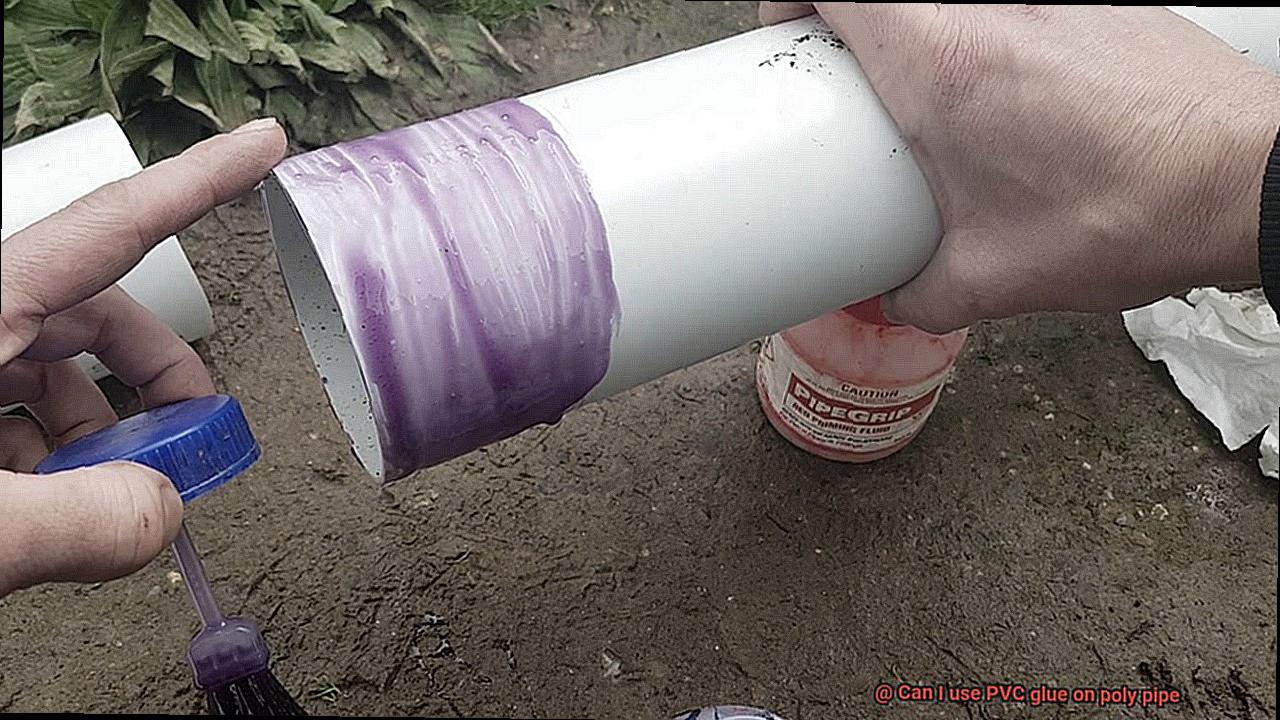
Why You Should Not Use PVC Glue on Poly Pipe
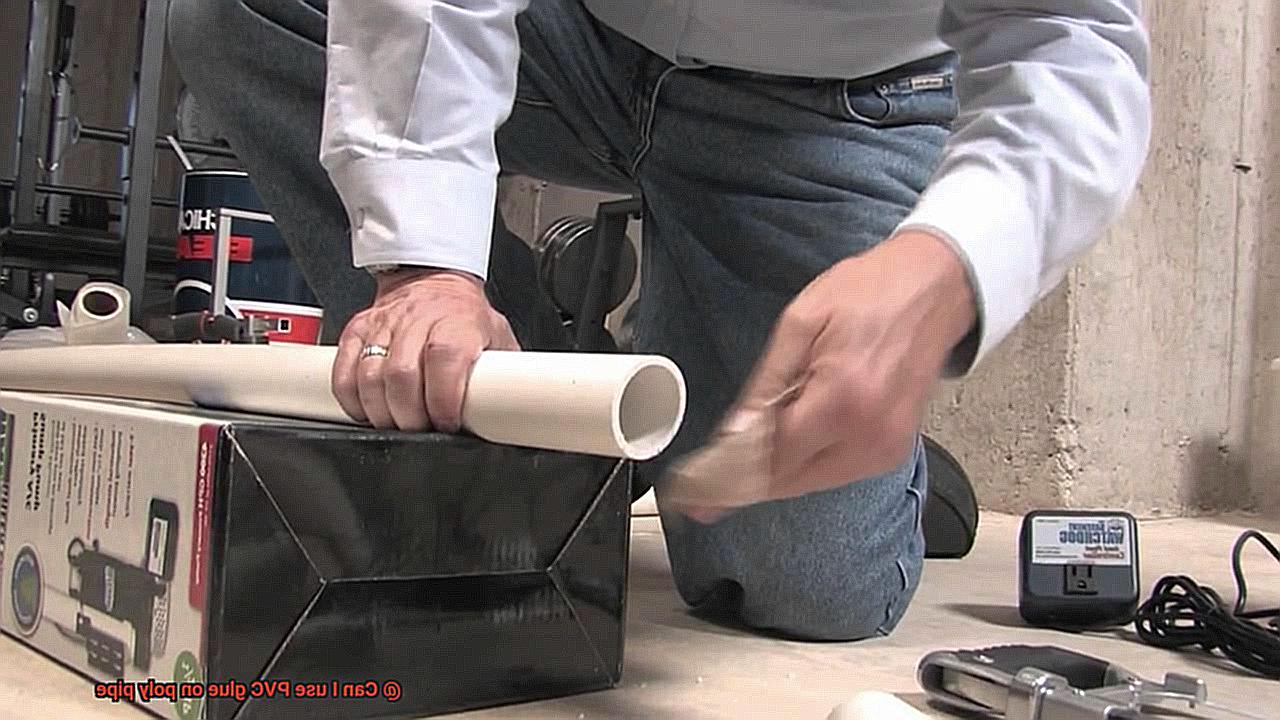
Today, we’re diving deep into the sticky topic of PVC glue and poly pipe. While PVC glue may work wonders for PVC pipes, it’s a different story when it comes to poly pipe. Let’s explore why using PVC glue on poly pipe is a recipe for disaster.
Chemical Clash:
PVC glue is formulated with solvents specifically designed to bond PVC materials together. However, these solvents can wreak havoc on polyethylene, the plastic used in poly pipe. The difference in chemical compositions means that PVC glue won’t effectively bond with poly pipe, leading to weak joints and potential leaks.
Properties at Risk:
Poly pipe is renowned for its flexibility, durability, and resistance to chemicals, corrosion, and weathering. But if you use PVC glue on poly pipe, you jeopardize these properties. The solvents in PVC glue can compromise the integrity of the polyethylene, weakening the overall strength and durability of the system.
Voiding Warranties:
Manufacturers often provide warranties or guarantees for their poly pipe products. However, using PVC glue on poly pipe can void these warranties. To ensure you’re covered in case of any issues, it’s crucial to follow the manufacturer’s guidelines and use the recommended adhesive or joining method.
Alternative Options:
Luckily, there are alternative methods available for joining or repairing poly pipe. Mechanical fittings, compression fittings, heat fusion, or specialized poly pipe adhesives are all suitable options for creating strong connections without compromising the integrity of the pipes.
Seek Professional Advice:
When working with poly pipe or any other type of piping material, it’s always wise to consult the manufacturer’s guidelines or seek professional advice. Using the wrong adhesive can lead to costly repairs or replacements down the line. Don’t let a simple mistake result in a plumbing nightmare.
What Adhesive to Use Instead of PVC Glue on Poly Pipe
Buckle up, because we’re about to explore a range of alternatives that will save the day.
First off, PVC glue, also known as solvent cement, is designed specifically for bonding PVC pipes and fittings together. It chemically melts the surfaces of PVC materials, creating a strong connection. But here’s the thing: poly pipe is made from high-density polyethylene (HDPE), which has a different chemical composition than PVC. This means that PVC glue won’t react with HDPE, resulting in a weak bond that won’t stand the test of time.
So, what can you use instead? Let’s start with mechanical fittings. Compression fittings and barbed fittings are fantastic alternatives to adhesive. These fittings provide a tight seal that securely holds the poly pipe in place without any need for glue. No mess, no fuss.
But if you’re a fan of adhesives, fear not. There is an adhesive specially designed for bonding HDPE materials – polyethylene adhesive. This magic potion creates a strong molecular bond between the surfaces of the poly pipe, ensuring a leak-free connection. Just remember to follow the manufacturer’s instructions, clean and dry the surfaces before application, and hold the joint firmly until the adhesive cures.
Now, let’s not forget about fusion welding. Some types of poly pipe come with pre-installed fusion-welded joints. This method involves melting the ends of the poly pipe and fusing them together using heat and pressure. The result? A seamless and permanent connection that doesn’t require any additional adhesive.
How to Prepare the Surface of Poly Pipe for Adhesive Bonding
Creating strong and reliable pipe connections is crucial for plumbing and irrigation projects. One effective method of joining pipes is adhesive bonding, which requires proper surface preparation for optimal results.
In this blog post, we will uncover the secrets to preparing the surface of poly pipe for adhesive bonding, guaranteeing a durable connection that withstands the test of time.
Why Surface Preparation Matters
Before diving into the surface preparation steps, it is important to understand why it is crucial. Proper surface preparation ensures that the adhesive can bond effectively with the poly pipe, creating a strong and long-lasting connection. By removing dirt, dust, grease, and other contaminants, we create an ideal surface for the adhesive to work its magic.
Cleaning the Surface
The first step in preparing poly pipe for adhesive bonding is cleaning the surface. Gently wipe down the pipe with a soft cloth or brush to remove any dirt or debris. This step ensures that no pesky particles interfere with the adhesive’s ability to bond properly. Imagine a pristine canvas awaiting a masterpiece—the clean surface sets the stage for a flawless connection.
Roughening Up the Surface
Once the pipe is clean, it’s time to roughen up the surface slightly. Grab some sandpaper or a wire brush and gently rub it in circular motions across the pipe’s surface. This creates a textured finish that enhances the adhesive’s grip, allowing it to hold on tight to the poly pipe. Think of it as creating tiny mountains and valleys on the surface—providing footholds for the adhesive to firmly grasp onto.
Degreasing for Success
Next up is degreasing the poly pipe. This step is crucial as any traces of oil or grease can hinder the adhesive bond. Apply a suitable degreaser using a clean cloth or sponge and ensure every inch of the pipe is covered. Let it sit for the recommended time specified by the degreaser manufacturer to dissolve and remove any grease or oil present. This step ensures a clean slate, free from any slippery substances that could undermine the adhesive’s strength.
Rinse and Repeat
After the degreaser has worked its magic, rinse the poly pipe with clean water to remove any residue. It’s vital to ensure all traces of degreaser are thoroughly rinsed away before moving on to adhesive application. This step guarantees a clean and ready-to-bond surface. Imagine a refreshing waterfall washing away any remnants of degreaser, leaving behind a pristine canvas for the adhesive to work its wonders.
Instructions for Applying Specialized Adhesives to Poly Pipe
Poly pipe, also known as polyethylene pipe, is a popular choice for water distribution and plumbing applications due to its flexibility and durability. To create strong and reliable connections with poly pipe, it is essential to apply specialized adhesives correctly. Follow these steps to ensure a successful application:
- Clean the Surface: Before applying any adhesive, thoroughly clean the surface of the poly pipe. Use a clean cloth to remove any dirt, grease, or contaminants. If necessary, use a mild detergent solution for a deeper clean. A clean surface is crucial for achieving a strong bond.
- Choose the Right Adhesive: Select an adhesive specifically formulated for polyethylene materials. Polyethylene adhesive or poly pipe glue is commonly used. Ensure that the adhesive is designed for your specific type of poly pipe and follow the manufacturer’s instructions for application.
- Apply the Adhesive: Use a brush or applicator to evenly apply the adhesive to both surfaces that are being joined. Take care not to apply too much adhesive, as excess glue can be squeezed out during assembly. Spread the adhesive evenly over the joint area.
- Join the Pipe: Once the adhesive is applied, firmly hold the two pieces of poly pipe together for the recommended curing time specified by the manufacturer. This allows the adhesive to cure and create a strong bond between the pipes. Curing times may vary depending on the adhesive and environmental factors.
- Test for Leaks: After the adhesive has fully cured, test the joint for leaks or signs of weakness before putting it into service. Apply pressure to the joint or conduct a water pressure test if applicable. If any leaks or weak spots are detected, consider reapplying the adhesive or using a different adhesive for a stronger bond.
-SFWiCAhhHk” >
Conclusion
In conclusion, it is strongly advised against using PVC glue on poly pipe. While PVC glue may work wonders for bonding PVC materials together, it is simply not compatible with polyethylene, the plastic used in poly pipe. The distinct chemical compositions of PVC and polyethylene prevent the solvents in PVC glue from effectively bonding with poly pipe, resulting in feeble joints and the potential for troublesome leaks.
Not only that, but using PVC glue on poly pipe can jeopardize the very properties that make polyethylene such a fantastic choice. Poly pipe boasts flexibility, durability, and resilience against chemicals and weathering. Unfortunately, the solvents in PVC glue have a knack for weakening the integrity of polyethylene, undermining its strength and endurance.
Thankfully, there are alternative methods available for joining or repairing poly pipe that do not involve the use of PVC glue. Mechanical fittings like compression fittings or barbed fittings offer secure connections without relying on adhesive. Additionally, there are specialized adhesives specifically designed to bond polyethylene pipes together, creating a robust molecular bond between their surfaces.
When working with poly pipe or any other type of piping material, it is always wise to consult the manufacturer’s guidelines or seek professional advice. Using an incorrect adhesive can lead to costly repairs or replacements further down the line.

